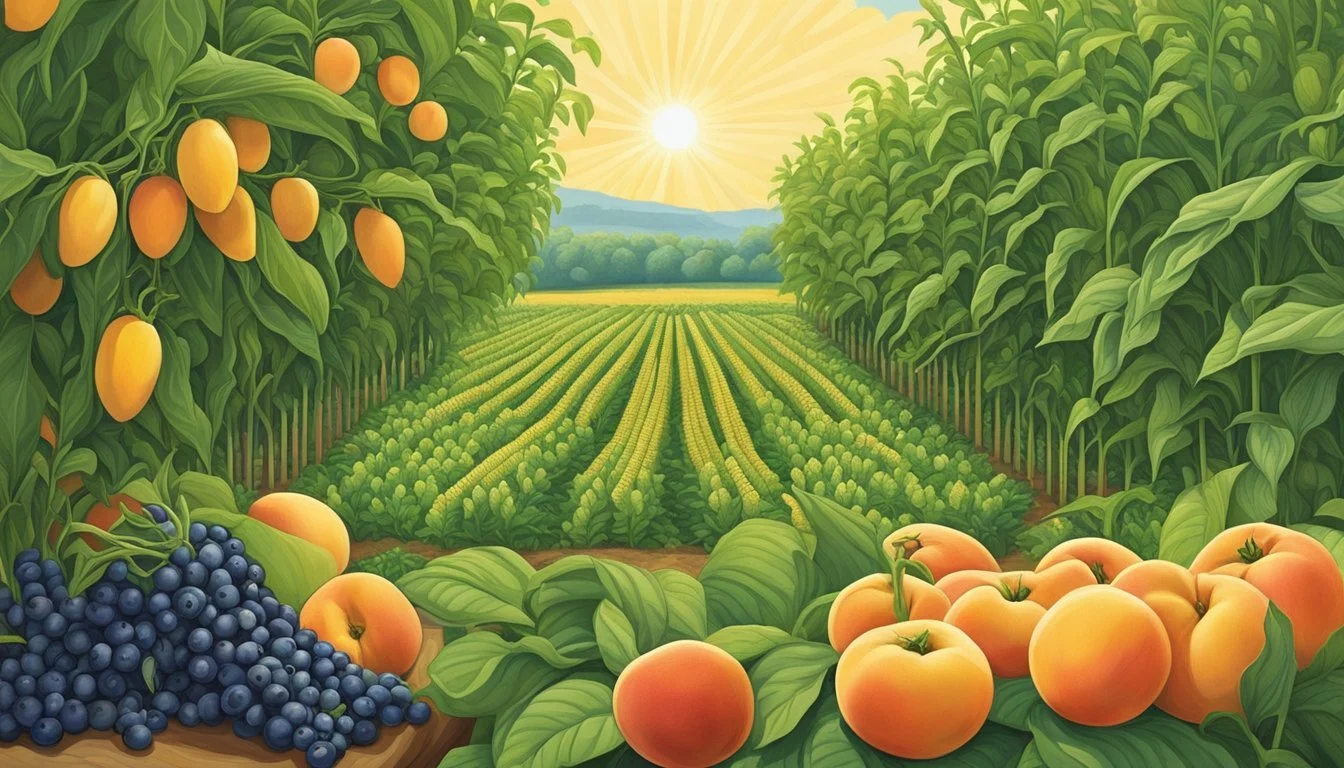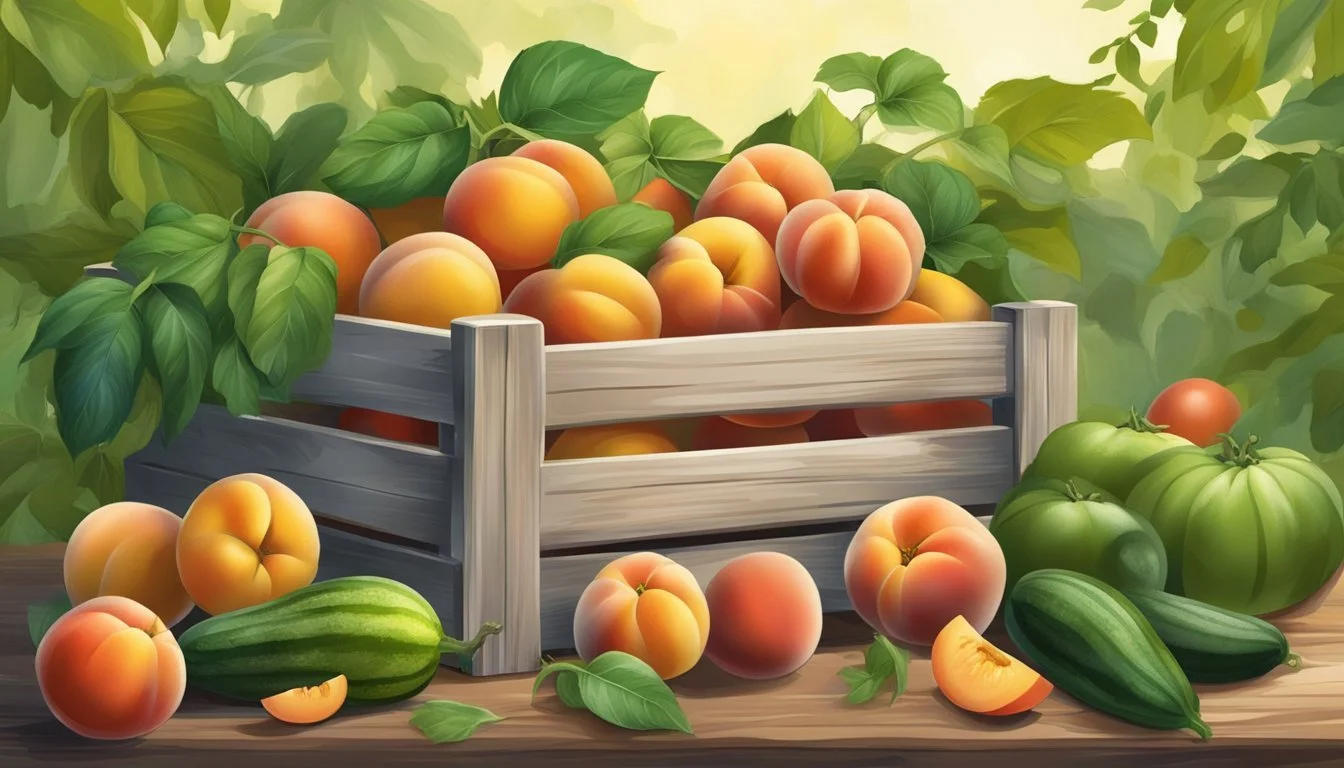Ohio Seasonal Fruit & Vegetables in July
Your Fresh Picks Guide
This Article is Part of our Ohio Seasonal Fruit & Veg Calendar
In July, the warmth of the Ohio summer sun nurtures a bountiful assortment of fruits and vegetables, marking a peak in the local harvest season. During this month, Ohioans take pleasure in a colorful variety of produce straight from the fields to their tables. This period is characterized by the ripening of several stone fruits, including cherries (how long do cherries last?)and peaches, which join a selection of berries in reaching their flavorful prime. Consumers value this season for its fresh, succulent fruits that embody the essence of summer.
Vegetable plots and markets across the state also flourish with a range of fresh produce. Tomatoes, sweet corn, and zucchini (What wine goes well with zucchini?) are among the staples that enter their optimal harvesting time, offering a taste of the region's agricultural capabilities. The agricultural landscape is dotted with community-supported agriculture programs and farmers' markets, where the hauls of July are celebrated for their freshness and quality.
Ohio's July harvest is not just a boon for food enthusiasts and home cooks; it is also pivotal for local economies and the farm-to-table movement, which emphasizes direct access to food produced within the community. Seasonal offerings support sustainable practices and encourage culinary adventures, allowing individuals to explore a variety of flavors while supporting Ohio's farming community.
Understanding Ohio's Growing Season
Ohio's growing season is defined by its temperate climate, which influences the planting and harvesting times of various crops. This section discusses the key growing periods, the effects of climate on crop production, and provides a month-by-month overview of seasonality.
Key Growing Periods
The peak growing period in Ohio typically spans from April to October, where the environment is conducive to cultivating a wide range of fruits and vegetables. July is a particularly crucial month as it often signifies the beginning of the harvest for many summer crops.
April–May: Preparations and planting begin, with the soil warming up and last frost dates passing.
June–July: Many crops reach key growth stages and temperatures are optimal.
August–September: Continuation of the growing season, with late summer crops beginning to mature.
October: Harvesting of late-season crops and preparation for winter.
Climate's Effect on Crops
The climate in Ohio impacts both the variety and the success rate of crops grown. Summer months can experience a range of weather conditions, from hot, humid days to sudden storms, influencing growing conditions and harvest periods.
Temperature Ranges:
July and August: Highs average in the mid-80s (°F), lows in the mid-60s (°F)
September and October: Cooler temperatures bring the harvest of fall crops.
Precipitation:
Consistent rain throughout the growing season can affect harvest times and crop quality.
Month-By-Month Seasonality
Ohio's monthly breakdown showcases the availability and harvest times of produce, with July being integral for summer varieties.
July:
Fruits: Berries like blueberries and raspberries are typically ready for harvest.
Vegetables: Sweet corn, tomatoes, and peppers hit their peak.
August and September:
Transition from summer to fall crops, such as apples and pumpkins, begins.
October:
End of the growing season with the final harvests of autumnal produce like squash.
July's Seasonal Harvest
In July, Ohio's farms are abundant with a variety of fresh fruits and vegetables. The warm temperatures and longer days contribute to optimal growing conditions for the month's harvest periods.
Fruits Available in July
Berries: July offers the last of the strawberry season and brings fresh blueberries and raspberries to the local markets.
Stone Fruits: Peaches and cherries are at their peak of ripeness and flavor.
Melons: Watermelons and cantaloupes (how long does cantaloupe last?) become readily available, ideal for summer refreshment.
Vegetables Available in July
Leafy Greens: Spinach and lettuces thrive in the early part of the month before the heat intensifies.
Tomatoes: Various varieties of tomatoes ripen in July, ranging from heirlooms to cherry tomatoes.
Root Vegetables: Beets (how long do beets last?) and carrots are harvested, full of sweetness and earthy flavors. (What wine goes well with earthy flavors?)
Summer Squash: Zucchini and yellow squash are in abundance, perfect for grilling or sautéing.
Featured Ohio Produce
In July, Ohio's farms offer a bounty of stone fruits and berries along with a multitude of garden vegetables and leafy greens, ensuring a rich selection for consumers and local markets.
Stone Fruits and Berries
Peaches: Ohio's summer climate cultivates juicy peaches, most abundant in July. They vary from clingstone to freestone, the latter being ideal for canning and baking.
Nectarines and Berries: Similar to peaches, nectarines thrive in Ohio's July weather. This month also witnesses a peak in blackberries and blueberries, with their respective harvests offering sweet and tart flavors; while raspberries start their season, signifying variety on the berry front.
Garden Vegetables and Leafy Greens
Tomatoes and Cucumbers: Ohioans enjoy a rich yield of tomatoes ranging from heirloom to cherry varieties. Cucumbers flourish alongside, perfect for salads or pickling.
Squash and Eggplant (What wine goes well with eggplant?): Zucchini and yellow squash are staples in the summer garden, versatile for many recipes. Eggplant, with its glossy skin, is also ready for harvest, making it a favorite for grilling or as a meat substitute.
Beets and Leafy Greens: Root vegetables like beets are pulled from the soil, their earthy flavor a complement to any dish. Leafy greens remain a constant, with varieties such as spinach offering continuous harvest.
This section outlines some of the fresh, local produce that consumers can look forward to in Ohio during the month of July.
Farm-to-Table: Maximizing Freshness and Flavor
In Ohio, the farm-to-table movement emphasizes securing the freshest, most flavorful produce right from local farms through optimal storage and handling practices.
Local Farmers and Markets
Ohio farmers take pride in offering a variety of produce directly accessible through local markets during July. Among the crops harvested are tomatoes, sweet corn, zucchini, and peppers. These farmers employ sustainable agricultural practices to ensure that the produce consumers receive is not only fresh but also retains maximum flavor. The intimate knowledge Ohio farmers have of their produce also allows them to pick fruits and vegetables at peak ripeness.
Local Availability in July:
Fruits: Berries, Peaches, Cherries
Vegetables: Tomatoes, Cucumbers, Green Beans
Engaging with Ohio's agriculture through these markets supports the local economy and guarantees the consumer benefits from the shortest possible field-to-fork travel time.
Best Practices for Freshness
Timely harvesting and proper storage techniques are critical for maintaining maximum freshness and flavor. Ohio farmers understand the importance of temperature control, humidity, and timing in their storage facilities to preserve the quality of their produce.
Tomatoes: Best kept at room temperature away from direct sunlight until ripe; refrigeration can diminish flavor.
Berries: Should be refrigerated and kept in their original container; rinse only before consuming to prevent mold growth.
Leafy Greens: Store in a moisture-proof bag with air removed; keep in the refrigerator crisper to extend freshness.
These simple yet effective storage methods ensure that consumers enjoy the true taste of Ohio's July bounty with every bite.
Preparing and Preserving Seasonal Produce
In Ohio, July yields a bounty of fresh fruits and vegetables. Utilizing the right cooking and preservation methods not only extends their shelf life but also enhances the flavors of the season.
Cooking and Recipe Ideas
Hearty dishes and refreshing desserts can make the most of Ohio's July produce. One can use ripe tomatoes and cucumbers in vibrant salads or salsas. Fresh berries are perfect for homemade jam, while juicy peaches can be baked into pies or cobblers. Green beans are great when sautéed, and sweet corn can be enjoyed grilled or as a feature in summer chowders.
Tomatoes & Cucumbers: Salsa, Greek Salad
Berries: Jam, Fruit Tarts
Peaches: Cobbler, Pie, Grilled
Green Beans: Sautéed with Garlic
Sweet Corn: Grilled, Corn Chowder
Preservation Techniques
Proper storage and preservation techniques ensure that the flavor and quality of produce are maintained. Freezing is a straightforward method suitable for many fruits and vegetables; it retains most of their nutrients and taste. Creating pickles from cucumbers or other vegetables can add a savory snack to the pantry. When making jam, one must ensure to follow safe canning practices to avoid food spoilage. For longer storage, drying fruits and making sauces or ketchups are effective preservation methods.
Freezing: Berries, Corn, Peaches (blanched and sliced)
Pickling: Cucumbers, Green Beans
Jam: Berries (using a water bath canning method)
Sauces and Ketchups: Tomatoes (with proper canning techniques)
Drying: Greens or Herbs (in a dehydrator or a low-heat oven)
Seasonal Agriculture and Economic Impact
Seasonal agriculture significantly influences Ohio's economy, with crops grown in July contributing to both local and statewide economic health.
Agriculture's Role in Ohio
In Ohio, agriculture stands as a cornerstone of the state's economic structure. The state is known for a diverse array of crops, including those reaching their peak in July such as sweet corn, tomatoes, and berries. This sector not only sustains the livelihood of farmers but also supports ancillary industries throughout the supply chain, from transportation to retail.
Seasonality and Local Economy
Seasonal fluctuations directly affect the local economy, especially when it comes to fresh produce. As crops such as blueberries become ripe for harvest in July, local markets and roadside stands experience an influx of customers seeking seasonal fruits and vegetables. This uptick in local commerce bolsters small businesses and can influence consumer spending patterns, keeping money within the community and enriching the state's economic vitality.








